Abstract
This article describes environmental public health surveillance and proposes a framework to enhance its practice in the United States. Special issues for surveillance in environmental public health are examined, and examples of existing systems useful for environmental public health practice are provided. Current and projected surveillance needs, as well as potential sources of data, are examined. The proposed framework for conducting environmental public health surveillance involves data from three points in the process by which an agent in the environment produces an adverse outcome in a host: hazards, exposures, and outcomes. Environmental health practitioners should build on efforts in other fields (e.g., infectious diseases and occupational health) to establish priorities in the surveillance of health conditions associated with exposure to environmental toxicants. For specific surveillance programs, existing data systems, as well as data gaps, should be identified. Coordinated surveillance systems can facilitate public health efforts to prevent and control disease, injury, and disability related to the interaction between people and their environment.
Full text
PDF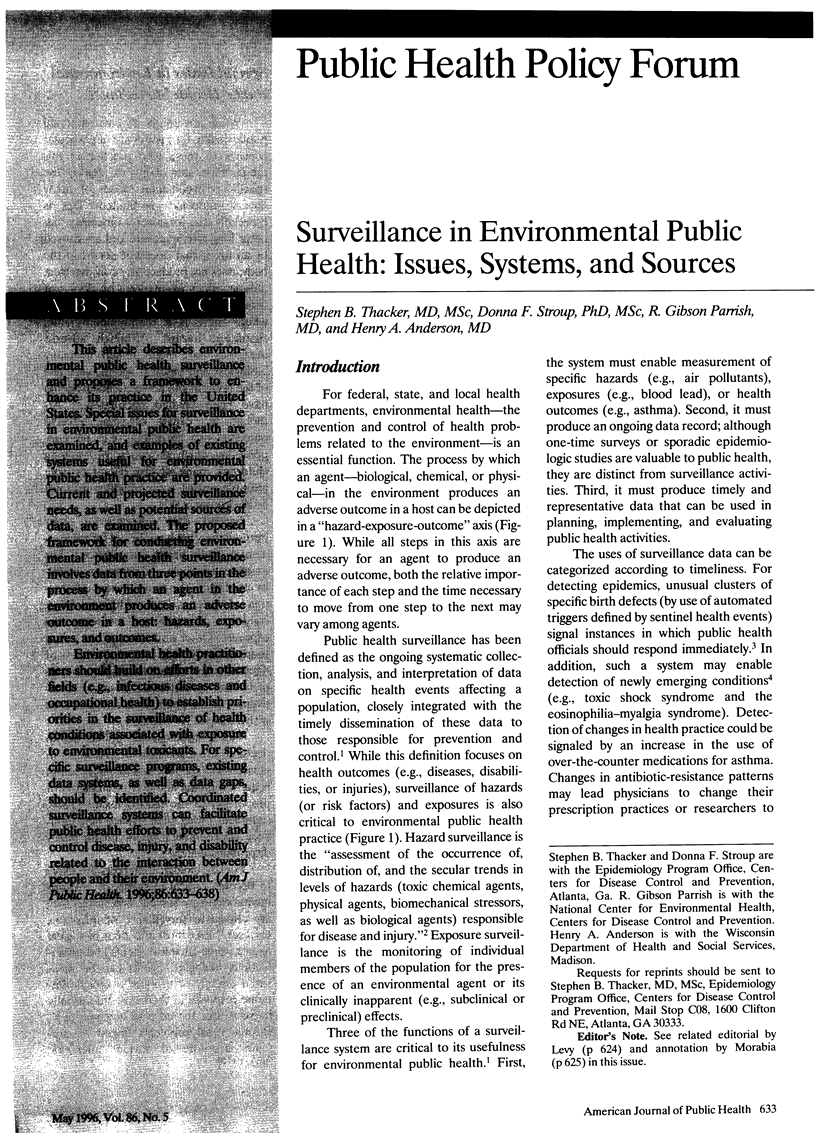
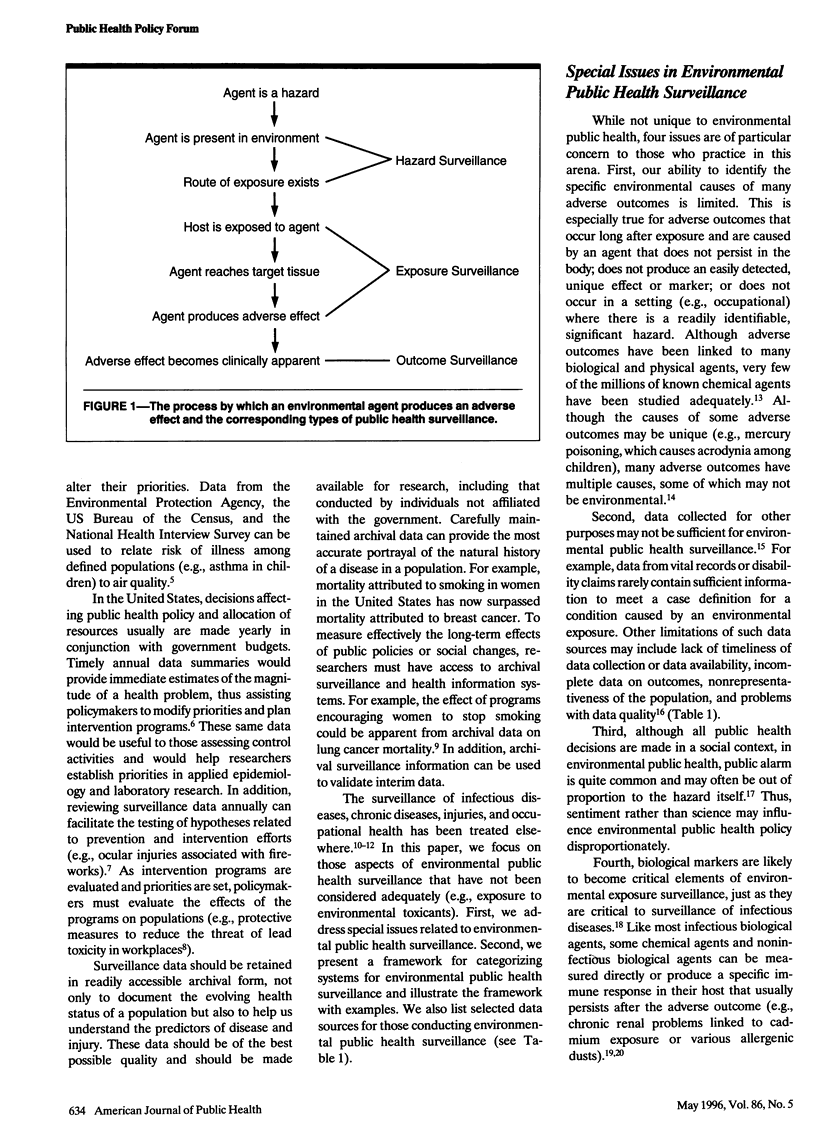
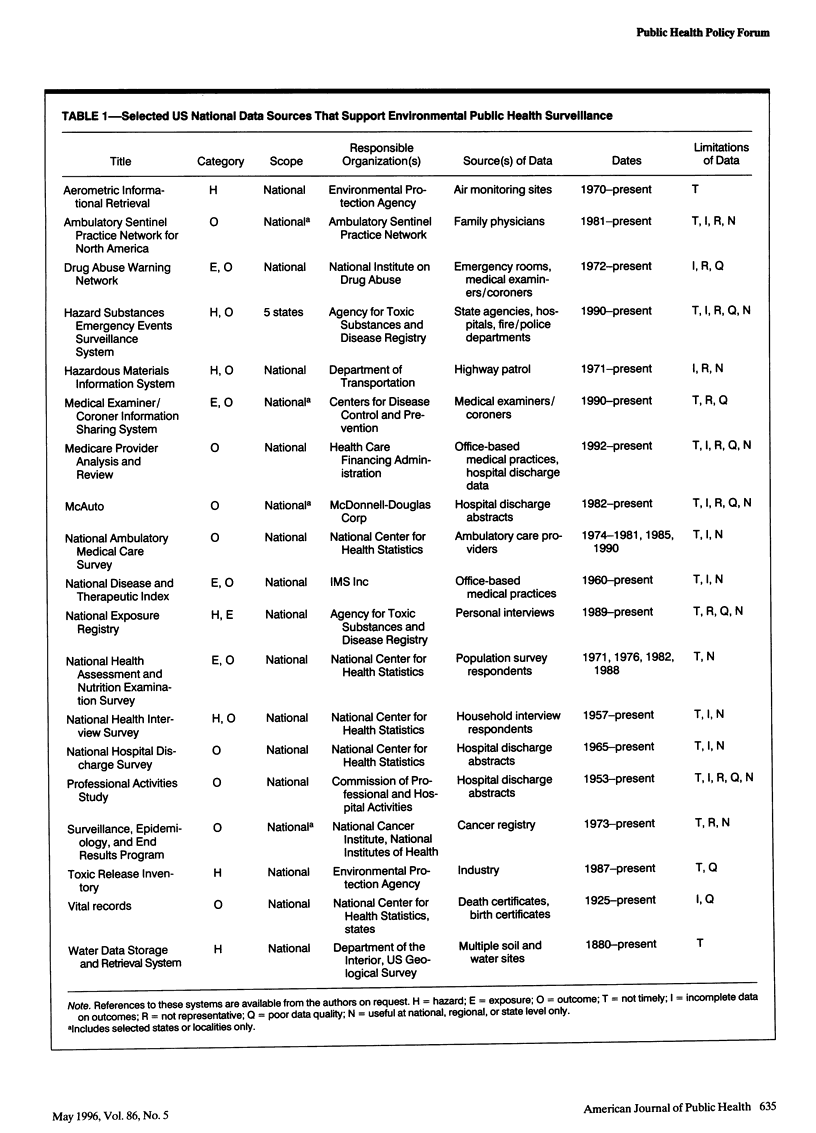
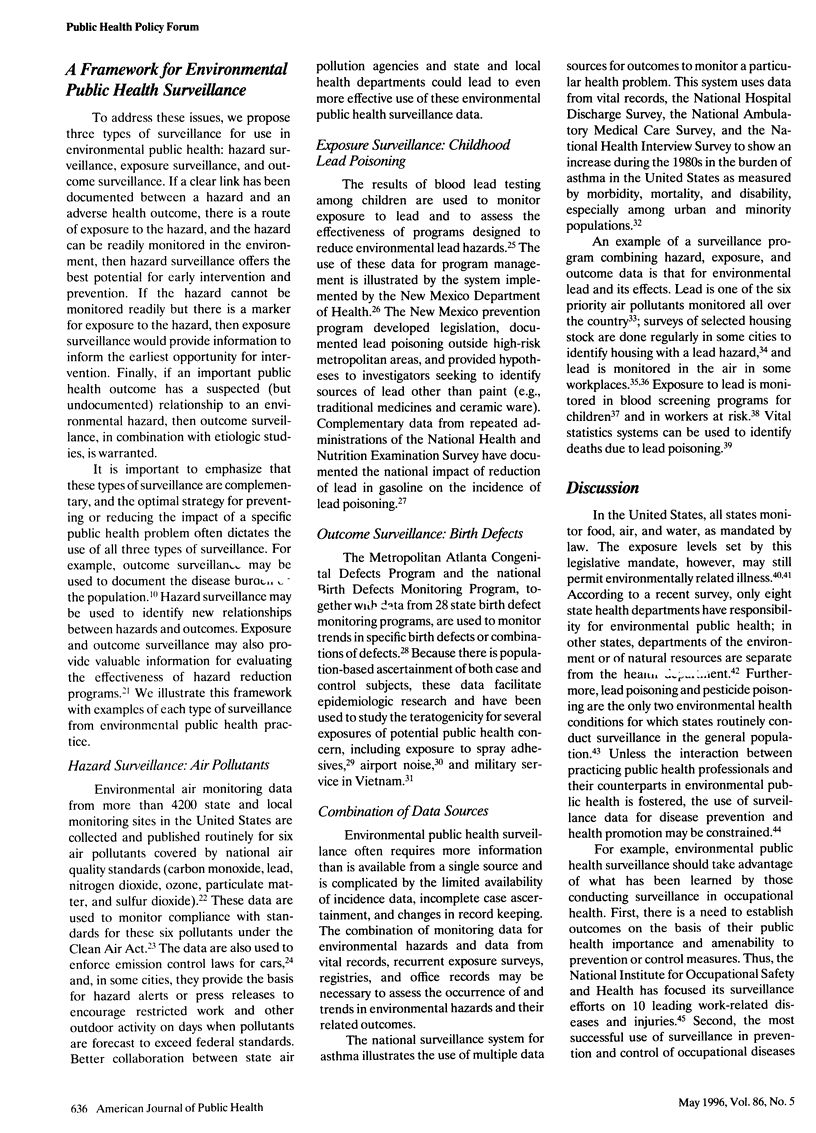
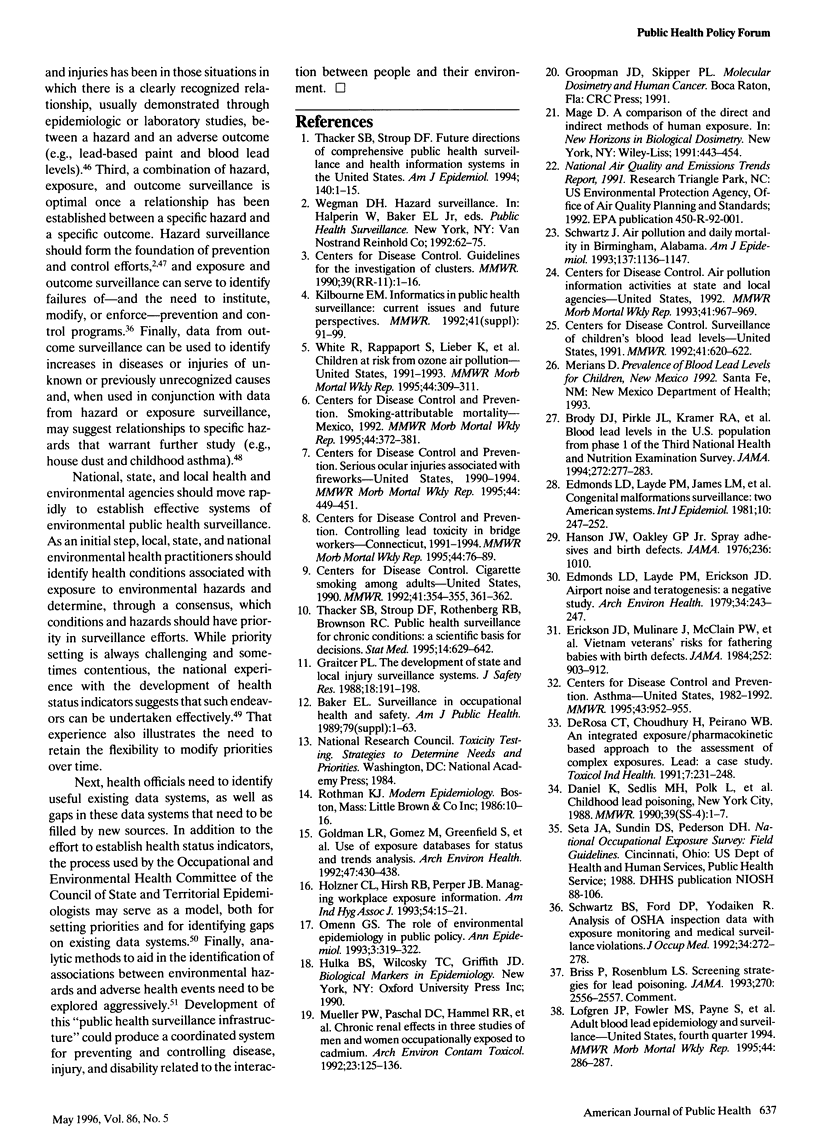
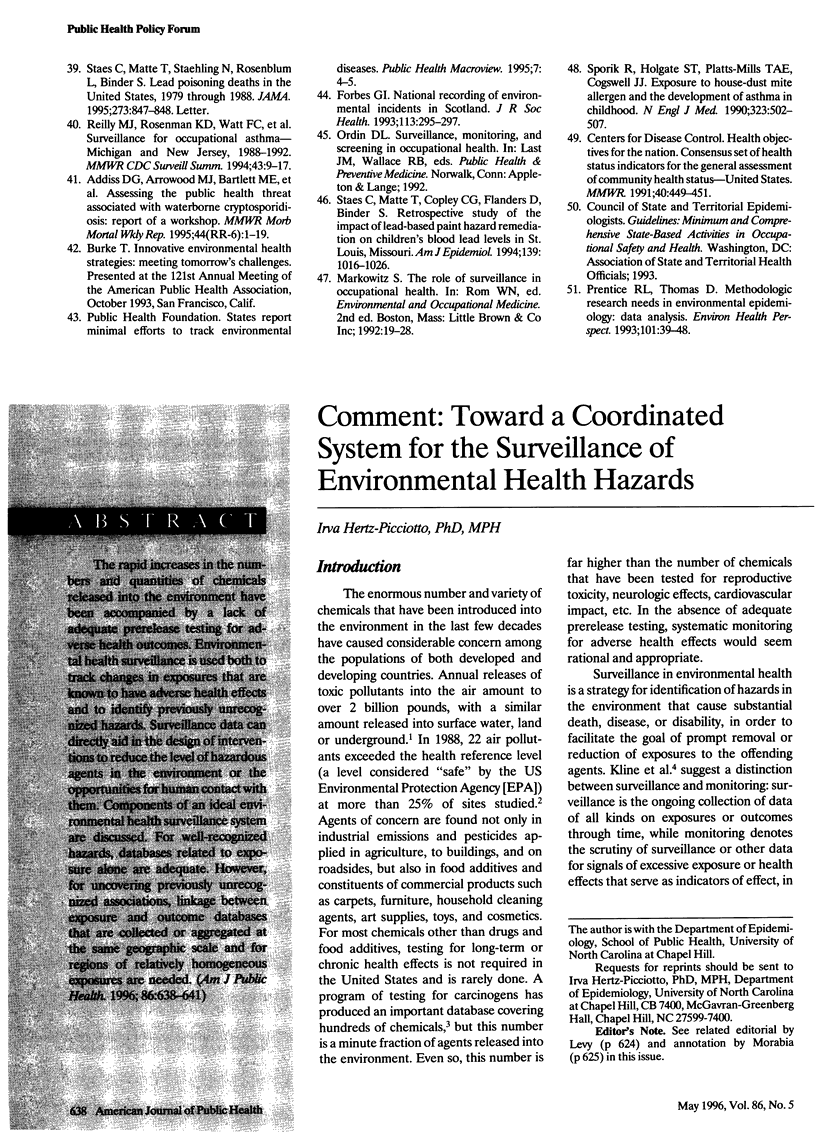
Selected References
These references are in PubMed. This may not be the complete list of references from this article.
- Baker E. L. Surveillance in occupational health and safety. Challenges for the future. Am J Public Health. 1989 Dec;79 (Suppl):61–63. doi: 10.2105/ajph.79.suppl.61. [DOI] [PMC free article] [PubMed] [Google Scholar]
- Briss P. A., Rosenblum L. S. Screening strategies for lead poisoning. JAMA. 1993 Dec 1;270(21):2556–2557. doi: 10.1001/jama.1993.03510210041016. [DOI] [PubMed] [Google Scholar]
- Brody D. J., Pirkle J. L., Kramer R. A., Flegal K. M., Matte T. D., Gunter E. W., Paschal D. C. Blood lead levels in the US population. Phase 1 of the Third National Health and Nutrition Examination Survey (NHANES III, 1988 to 1991) JAMA. 1994 Jul 27;272(4):277–283. doi: 10.1001/jama.272.4.277. [DOI] [PubMed] [Google Scholar]
- Centers for Disease Control and Prevention (CDC) Children at risk from ozone air pollution--United States, 1991-1993. MMWR Morb Mortal Wkly Rep. 1995 Apr 28;44(16):309–312. [PubMed] [Google Scholar]
- Centers for Disease Control and Prevention (CDC) Injuries associated with use of snowmobiles--New Hampshire, 1989-1992. MMWR Morb Mortal Wkly Rep. 1995 Jan 13;44(1):1–3. [PubMed] [Google Scholar]
- Daniel K., Sedlis M. H., Polk L., Dowuona-Hammond S., McCants B., Matte T. D. Childhood lead poisoning, New York City, 1988. MMWR CDC Surveill Summ. 1990 Dec;39(4):1–7. [PubMed] [Google Scholar]
- DeRosa C. T., Choudhury H., Peirano W. B. An integrated exposure/pharmacokinetic based approach to the assessment of complex exposures. Lead: a case study. Toxicol Ind Health. 1991 Jul;7(4):231–248. doi: 10.1177/074823379100700401. [DOI] [PubMed] [Google Scholar]
- Edmonds L. D., Layde P. M., Erickson J. D. Airport noise and teratogenesis. Arch Environ Health. 1979 Jul-Aug;34(4):243–247. doi: 10.1080/00039896.1979.10667407. [DOI] [PubMed] [Google Scholar]
- Edmonds L. D., Layde P. M., James L. M., Flynt J. W., Erickson J. D., Oakley G. P., Jr Congenital malformations surveillance: two American systems. Int J Epidemiol. 1981 Sep;10(3):247–252. doi: 10.1093/ije/10.3.247. [DOI] [PubMed] [Google Scholar]
- Erickson J. D., Mulinare J., McClain P. W., Fitch T. G., James L. M., McClearn A. B., Adams M. J., Jr Vietnam veterans' risks for fathering babies with birth defects. JAMA. 1984 Aug 17;252(7):903–912. [PubMed] [Google Scholar]
- Forbes G. I. National recording of environmental incidents in Scotland. J R Soc Health. 1993 Dec;113(6):295–297. doi: 10.1177/146642409311300604. [DOI] [PubMed] [Google Scholar]
- Goldman L. R., Gomez M., Greenfield S., Hall L., Hulka B. S., Kaye W. E., Lybarger J. A., McKenzie D. H., Murphy R. S., Wellington D. G. Use of exposure databases for status and trends analysis. Arch Environ Health. 1992 Nov-Dec;47(6):430–438. doi: 10.1080/00039896.1992.9938384. [DOI] [PubMed] [Google Scholar]
- Hanson J. W., Oakley G. P. Spray adhesives and birth defects. JAMA. 1976 Aug 30;236(9):1010–1010. doi: 10.1001/jama.236.9.1010a. [DOI] [PubMed] [Google Scholar]
- Holzner C. L., Hirsh R. B., Perper J. B. Managing workplace exposure information. Am Ind Hyg Assoc J. 1993 Jan;54(1):15–21. doi: 10.1080/15298669391354252. [DOI] [PubMed] [Google Scholar]
- Kilbourne E. M., Centers for Disease Control (CDC) Informatics in public health surveillance: current issues and future perspectives. MMWR Morb Mortal Wkly Rep. 1992 Dec;41 (Suppl):91–99. [PubMed] [Google Scholar]
- Mage D. A comparison of the direct and indirect methods of human exposure. Prog Clin Biol Res. 1991;372:443–454. [PubMed] [Google Scholar]
- McMichael A. J. Invited commentary--"molecular epidemiology": new pathway or new travelling companion? Am J Epidemiol. 1994 Jul 1;140(1):1–11. doi: 10.1093/oxfordjournals.aje.a117153. [DOI] [PubMed] [Google Scholar]
- Mueller P. W., Paschal D. C., Hammel R. R., Klincewicz S. L., MacNeil M. L., Spierto B., Steinberg K. K. Chronic renal effects in three studies of men and women occupationally exposed to cadmium. Arch Environ Contam Toxicol. 1992 Jul;23(1):125–136. doi: 10.1007/BF00226005. [DOI] [PubMed] [Google Scholar]
- Omenn G. S. The role of environmental epidemiology in public policy. Ann Epidemiol. 1993 May;3(3):319–322. doi: 10.1016/1047-2797(93)90036-4. [DOI] [PubMed] [Google Scholar]
- Prentice R. L., Thomas D. Methodologic research needs in environmental epidemiology: data analysis. Environ Health Perspect. 1993 Dec;101 (Suppl 4):39–48. doi: 10.1289/ehp.93101s439. [DOI] [PMC free article] [PubMed] [Google Scholar]
- Reilly M. J., Rosenman K. D., Watt F. C., Schill D., Stanbury M., Trimbath L. S., Romero Jajosky R. A., Musgrave K. J., Castellan R. M., Bang K. M. Surveillance for occupational asthma--Michigan and New Jersey, 1988-1992. MMWR CDC Surveill Summ. 1994 Jun 10;43(1):9–17. [PubMed] [Google Scholar]
- Schwartz B. S., Ford D. P., Yodaiken R. Analysis of OSHA inspection data with exposure monitoring and medical surveillance violations. J Occup Med. 1992 Mar;34(3):272–278. doi: 10.1097/00043764-199203000-00011. [DOI] [PubMed] [Google Scholar]
- Schwartz J. Air pollution and daily mortality in Birmingham, Alabama. Am J Epidemiol. 1993 May 15;137(10):1136–1147. doi: 10.1093/oxfordjournals.aje.a116617. [DOI] [PubMed] [Google Scholar]
- Sporik R., Holgate S. T., Platts-Mills T. A., Cogswell J. J. Exposure to house-dust mite allergen (Der p I) and the development of asthma in childhood. A prospective study. N Engl J Med. 1990 Aug 23;323(8):502–507. doi: 10.1056/NEJM199008233230802. [DOI] [PubMed] [Google Scholar]
- Staes C., Matte T., Copley C. G., Flanders D., Binder S. Retrospective study of the impact of lead-based paint hazard remediation on children's blood lead levels in St. Louis, Missouri. Am J Epidemiol. 1994 May 15;139(10):1016–1026. doi: 10.1093/oxfordjournals.aje.a116941. [DOI] [PubMed] [Google Scholar]
- Staes C., Matte T., Staeling N., Rosenblum L., Binder S. Lead poisoning deaths in the United States, 1979 through 1988. JAMA. 1995 Mar 15;273(11):847–848. [PubMed] [Google Scholar]
- Thacker S. B., Stroup D. F., Rothenberg R. B. Public health surveillance for chronic conditions: a scientific basis for decisions. 1995 Mar 15-Apr 15Stat Med. 14(5-7):629–641. doi: 10.1002/sim.4780140520. [DOI] [PubMed] [Google Scholar]


